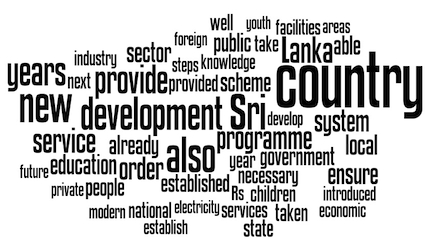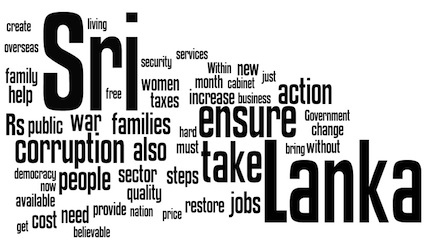Groundviews was the first website in Sri Lanka to visualise key statements by a Presidential candidate in the public domain. We followed up with a visualisation of Sarath Fonseka’s manifesto. The incumbent Executive’s manifesto was released in English on 14 January. On the website, it is called Mahinda Chinthana – Vision of Future. The cover page it says A Brighter Future and Mahinda Chintana: Vision for the Future. For the purpose of this article, we will call it Mahinda Chintanaya 2010. Whatever one calls this document, the emphasis very clearly is on the future of Sri Lanka, as envisioned by the incumbent.
As with Sarath Fonseka’s manifesto, to avoid allegations of the partial or selective use of content, click here for a raw text dump of the English PDF version of Mahinda Chintanaya 2010.

For easy visual comparison, we reproduce below the visualisation of Sarath Fonseka’s manifesto, which has been analysed in greater detail on Groundviews here.

There is a significant and unsurprising emphasis on country, development and creating / doing new things in the Mahinda Chintanaya 2010. For the incumbent, taking steps, action or measures to ensure various things is important. Programmes in support of various policies and practices, and development also come out quite clearly in the manifesto. As is to be expected from an incumbent seeking reelection, electricity, education, scheme, sector, industry, youth, facilities and other key phrases bring out a wide range of issues covered in the manifesto, which is markedly different to that of Sarath Fonseka, who focusses on a far more limited range of sectors and issues. The quality of largesse by the Executive runs throughout in the frequent use of provide and (will be) established throughout the document.
Interestingly, the manifesto does not have a single mention of human rights, reconciliation or peacebuilding. There are however numerous mentions of peace, for example on Page 61 where it is noted that “…now there is sustainable peace and this is what the people of the north and east expected and so did the rest of the country”. It is understood therefore that peace is largely seen as the absence of war for the incumbent. In 103 pages, democracy is only mentioned twice.
What do you think of the Mahinda Chintanaya 2010 visualisation and what it flags as Mahinda Rajapaksa’s vision for the future of Sri Lanka? How does it compare with that of Sarath Fonseka?
